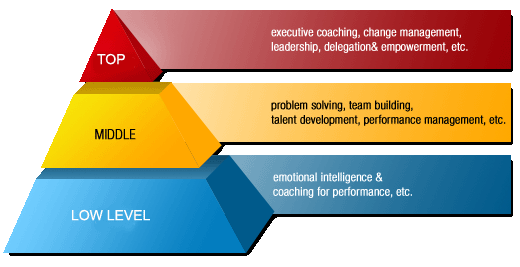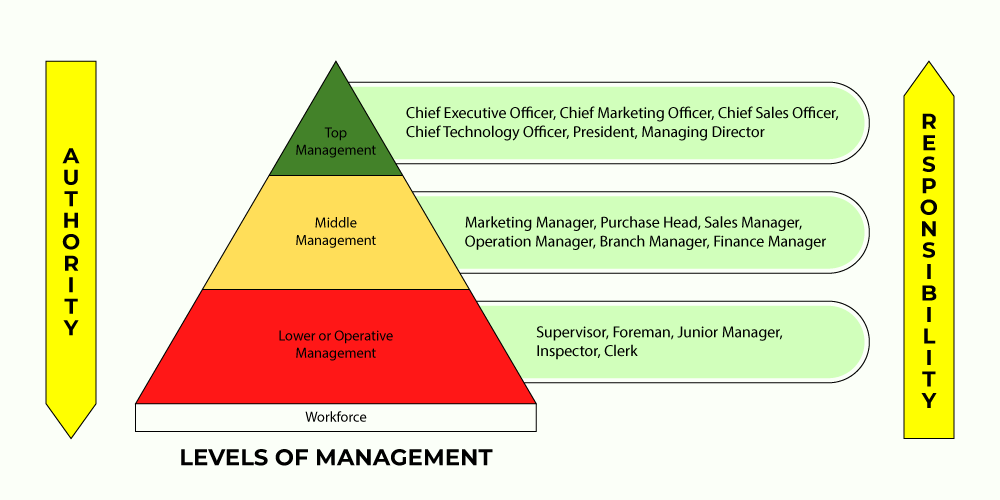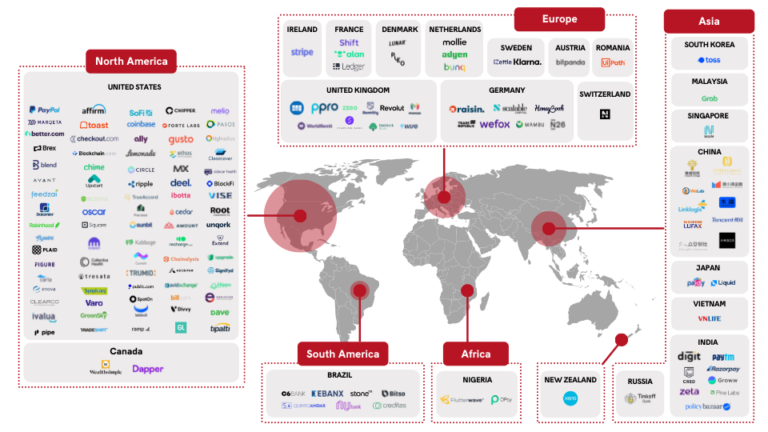What Is Top Level Of Management?
The top level of management, sometimes referred to as the executive level or C-level, includes the most senior leaders in an organization. These individuals are usually the board of directors, presidents, vice presidents, and chief executive officers. The top level of management is responsible for developing and implementing the overarching vision of the organization, as well as setting the direction for all operations. They are also responsible for making key decisions that affect the entire organization, such as budgeting, hiring, and strategic planning. Ultimately, the top level of management is responsible for ensuring that the organization reaches its goals and objectives.
Definition of Top Level of Management
Top level of management, also known as senior or executive management, is the highest level of organizational leadership responsible for making strategic decisions, setting organizational goals, and creating and implementing long-term plans. The top level of management is made up of the organization’s senior executives, which include the Chief Executive Officer (CEO), Chief Operating Officer (COO), Chief Financial Officer (CFO), and other members of the executive team. These executives are charged with creating strategies to ensure the organization’s success and provide direction to the organization. They are also responsible for overseeing the operations of the organization to ensure that it is meeting its strategic objectives.
The top level of management is responsible for setting the organization’s vision and mission and for developing strategies to achieve those objectives. They also provide guidance and direction to the organization’s staff and ensure that the organization is in compliance with applicable laws and regulations. In addition, these executives are responsible for establishing and maintaining relationships with stakeholders and customers. By providing strategic guidance and direction to the organization, top level of management is responsible for helping the organization reach its goals and objectives.
Types of Top Level of Management
Top level management is the highest level of organizational management, which is responsible for setting the overall strategy and direction of an organization. It is also responsible for making decisions on key areas, such as budgeting, resource allocation, and personnel. It is comprised of people who have the experience, knowledge, and skills to oversee the organization’s operations.
The top level of management is divided into two categories: executive management and board of directors. Executive management includes the CEO, CFO, and other key positions that are responsible for the day-to-day operations of the organization. The board of directors is a group of people responsible for setting the overall strategy of the organization, as well as ensuring compliance with laws and regulations.
Other levels of top management include senior management, middle management, and operational management. Senior management is responsible for the strategic direction of the organization and for making decisions on key areas, such as budgeting and resource allocation. Middle management is responsible for overseeing operations and ensuring that goals are met. Operational management is responsible for implementing the strategies and plans set by the top level of management.
Overall, top level of management is essential in order to ensure that an organization has clear objectives and is able to achieve them. It is also responsible for making sure that the organization is compliant with applicable laws and regulations. By understanding the different levels of top management, organizations can better ensure that their goals are met and that their operations are efficient and effective.
Qualities of Top Level of Management
The top level of management is a highly sought-after position within any organization. As the highest-ranking professionals in a company, the top-level managers are responsible for setting the direction and strategy of the organization and ensuring its success. It is a challenging role, and it requires a unique set of qualities and skills.
The most successful top-level managers are effective communicators who can clearly and persuasively articulate their vision and strategies. They are also emotionally intelligent, able to build strong relationships with their team, and to motivate and inspire them to achieve their goals. Top-level managers must also be confident decision makers, able to weigh the pros and cons of any situation and make the best decision for the organization.
Leadership is another important quality for top-level managers. They must be able to rally their team and guide them through difficult times. They must be able to delegate tasks and foster an environment of trust and respect.
Finally, top-level managers must be excellent problem solvers. They must be able to analyze complex situations and identify creative solutions. They must also be able to anticipate potential problems and take proactive steps to avoid them.
In summary, the top level of management requires a unique set of skills and qualities. From effective communication to creative problem solving, the successful top-level manager will possess a wide range of leadership and management capabilities.

Challenges Faced by Top Level of Management
Top-level management is the most important level of management in any organization. They are responsible for setting the vision and strategy of the company, as well as making key decisions that will drive the organization forward. However, this level of responsibility comes with its own unique set of challenges. Top-level managers must be able to effectively lead teams, manage budgets, and make tough decisions. They must be able to balance short-term goals with long-term objectives and consider the interests of all stakeholders. Additionally, they must be able to handle crises and navigate a rapidly changing business environment. To be successful, top-level managers must have a strong understanding of the company’s goals and objectives, as well as the strategies needed to achieve them. They must be able to stay ahead of trends and anticipate future changes in the market. Finally, they must be able to motivate their team, foster collaboration, and ensure that all members of the team are working towards a common goal. These challenges can be daunting, but with the right skills and strategies, top-level managers can ensure that their organization remains competitive in the ever-evolving business landscape.
Strategies for Effective Top Level of Management
Top level of management is the highest level of hierarchy in any organization, and it plays a major role in ensuring that the company runs smoothly and efficiently. Effective top-level management is critical for the success of a business, as it provides guidance and sets the tone for the rest of the employees. Achieving effective top-level management requires a combination of clear communication, careful planning, and consistent implementation of strategies.
When developing strategies for top-level management, it is important to keep the goals and objectives of the business in mind. These should be well-defined and communicated to all employees, so everyone is aware of the organization’s long-term goals and strategies. Once the goals and objectives are established, top-level management should decide on the best way to achieve them. This may involve setting up operational processes, developing a budget, and creating a timeline for implementation.
In order to ensure effective top-level management, it is essential to have strong leadership. Leaders should be able to motivate and inspire their team, set clear expectations, and provide guidance and support. They should also be capable of making difficult decisions and resolving conflicts. Additionally, they should be adept at developing strategies and ensuring that these are implemented in a timely manner.
Finally, effective top-level management also requires effective communication. This includes both internal and external communication. Internally, leaders should regularly communicate with their team and provide feedback and support. Externally, they should work to build relationships with other departments, vendors, and clients. Doing so will ensure that everyone within the organization is informed and on the same page.
Having an effective top-level management team is essential for the success of any organization. By following the strategies outlined above, leaders can ensure that their team is in a position to succeed and that the company is achieving its goals.
Benefits of an Effective Top Level of Management
Top level management is a critical component of any successful business. It is responsible for setting the direction, developing strategies, overseeing operations, and making key decisions. To ensure the success of a business, top level management must be effective. An effective top level of management yields many benefits.
Firstly, an effective top level of management helps to establish clear goals and objectives. This ensures that everyone in the organization is working towards the same purpose and that all activities are in line with the organization’s mission. Secondly, an effective top level of management helps to set a strong foundation for the company’s operations. This means that the organization will have a better chance of achieving long-term success.
Thirdly, an effective top level of management allows the organization to develop and implement effective strategies. This enables the organization to better compete in the market and to remain successful in the long run. Fourthly, an effective top level of management helps to create an environment of trust and respect. This ensures that everyone in the organization is working together to achieve the organization’s goals. Finally, an effective top level of management helps to ensure that the organization is able to respond quickly to changes in the external environment. This enables the organization to remain competitive and profitable.
In summary, an effective top level of management is essential for the success of any business. It helps to set clear goals and objectives, develop and implement effective strategies, create an environment of trust and respect, and respond quickly to changes in the external environment.
FAQs About the What Is Top Level Of Management?
Q1: What is the highest level of management?
A1: The highest level of management is the executive level, which includes the CEO, COO, CFO, and other top-level executives.
Q2: What responsibilities are typically held by top-level executives?
A2: Top-level executives are responsible for making strategic decisions about the company’s long-term goals and objectives. They also oversee the company’s operations and manage staff.
Q3: What qualifications are necessary to become a top-level executive?
A3: To become a top-level executive, you must have a combination of experience, education, and skills. Experience in the industry, an advanced degree, and strong leadership and communication skills are all important qualities for this position.
Conclusion
The top level of management, also known as the C-suite, is the highest level of leadership in a company. It consists of the Chief Executive Officer (CEO), Chief Operating Officer (COO), Chief Financial Officer (CFO), and other high-level executives. These individuals are responsible for setting the overall direction for the company, managing day-to-day operations, and ensuring the company’s long-term success. They also have the authority to make strategic decisions, hire and fire staff, and allocate resources. The top level of management is the driving force behind a company’s success and plays an essential role in its growth and prosperity.




